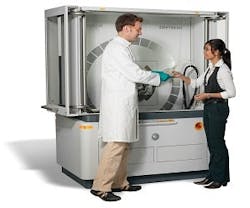PANalytical's Empyrean: The World of XRD Analysis is No Longer Flat
World leading X-ray analytical instrument manufacturer, PANalytical (Almelo, The Netherlands) has changed the game in multi-purpose X-ray diffraction (XRD) with the launch of its Empyrean high-performance diffractometer. Every major element of Empyrean is new: the X-ray source, the state-of-the-art goniometer, the sample stages and the radiation enclosure. Importantly, the instrument also introduces the world’s first 3D detection system, PIXcel3D.
As a result, Empyrean is unique in its ability to measure all sample types - from powders to thin films, from nanomaterials to 3D objects - on a single instrument. Users can switch between application setups in a fast and cost-effective way using PANalytical’s proven PreFIX modules, with no compromise on the quality of diffraction data. Empyrean is easy to use too. Dedicated hardware, software and regulatory expertise incorporated in pre-defined programs, and a customizable desktop and batch sample capabilities help make advanced functions accessible to all.
Dr. Martijn Fransen, Product Marketing Manager XRD commented: “Empyrean is PANalytical’s answer to the challenges of modern materials research. While today’s research themes are nanomaterials, life sciences and renewable energy tomorrow science may move in a totally different direction. The lifetime of a PANalytical diffractometer stretches further than the typical horizon of a single research program and, for many scientists, an ability to accommodate change is a ‘must-have’ feature in their decision to invest in an XRD system.”
For many users, powder samples are their primary interest and here Empyrean delivers the highest accuracy and data quality in the most flexible and advanced system on the market. Switching to thin films, Empyrean provides for high-resolution epitaxy analysis and handles all common applications. Investigations into nanomaterials can also be performed with Empyrean: size and shape of crystalline domains within the material, and structural analysis of near amorphous materials are all possible. PDF (pair distribution function), SAXS (small angle X-ray scattering), and even the ability to monitor the evolution of crystalline phases in situ with the unique slurry flow cell stage are all possible on the advanced Empyrean platform. Finally, the internal structure of solid objects can be studied without having to be cut: the unique PIXcel3D detector can be used as a CT scanner allowing non-destructive analysis of pharmaceutical formulations (tablets, capsules), electronic components (batteries, ICs, capacitors) and geo- and archaeological samples, to name a few.
